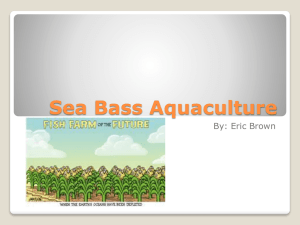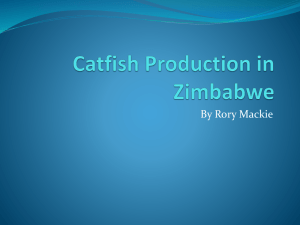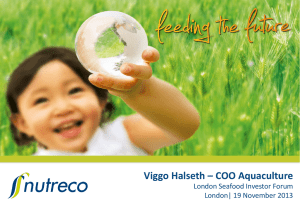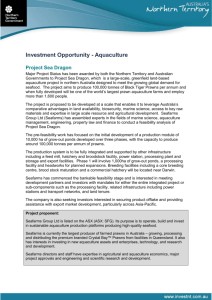EBR Response re Aquaculture May 26 2015
advertisement
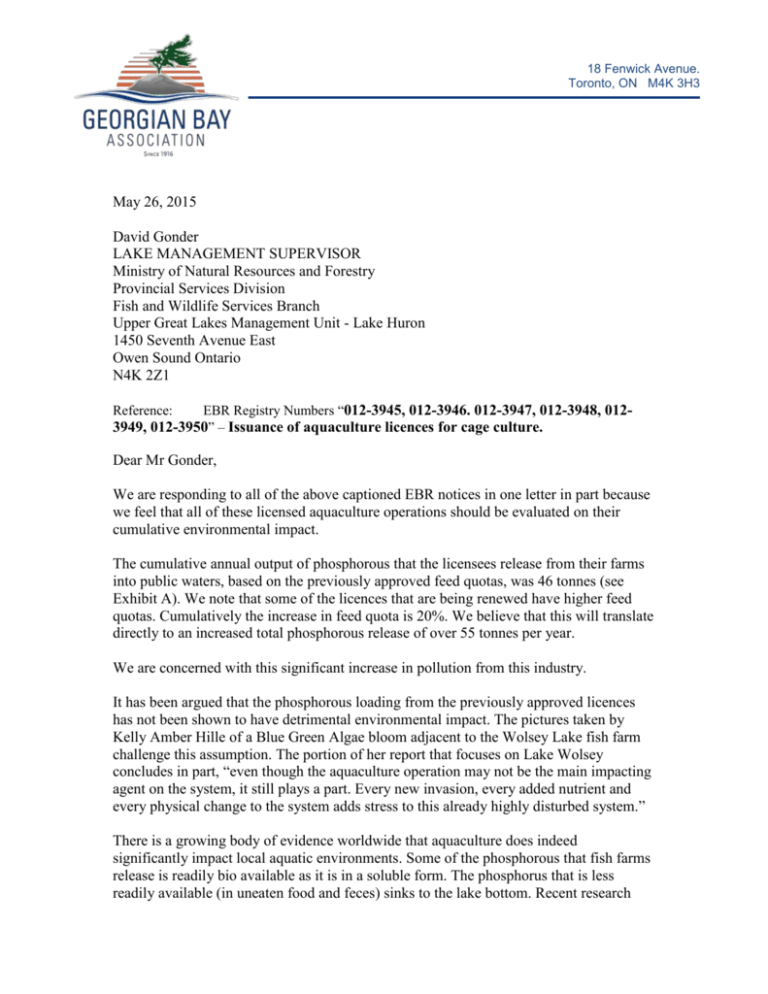
18 Fenwick Avenue. Toronto, ON M4K 3H3 May 26, 2015 David Gonder LAKE MANAGEMENT SUPERVISOR Ministry of Natural Resources and Forestry Provincial Services Division Fish and Wildlife Services Branch Upper Great Lakes Management Unit - Lake Huron 1450 Seventh Avenue East Owen Sound Ontario N4K 2Z1 EBR Registry Numbers “012-3945, 012-3946. 012-3947, 012-3948, 0123949, 012-3950” – Issuance of aquaculture licences for cage culture. Reference: Dear Mr Gonder, We are responding to all of the above captioned EBR notices in one letter in part because we feel that all of these licensed aquaculture operations should be evaluated on their cumulative environmental impact. The cumulative annual output of phosphorous that the licensees release from their farms into public waters, based on the previously approved feed quotas, was 46 tonnes (see Exhibit A). We note that some of the licences that are being renewed have higher feed quotas. Cumulatively the increase in feed quota is 20%. We believe that this will translate directly to an increased total phosphorous release of over 55 tonnes per year. We are concerned with this significant increase in pollution from this industry. It has been argued that the phosphorous loading from the previously approved licences has not been shown to have detrimental environmental impact. The pictures taken by Kelly Amber Hille of a Blue Green Algae bloom adjacent to the Wolsey Lake fish farm challenge this assumption. The portion of her report that focuses on Lake Wolsey concludes in part, “even though the aquaculture operation may not be the main impacting agent on the system, it still plays a part. Every new invasion, every added nutrient and every physical change to the system adds stress to this already highly disturbed system.” There is a growing body of evidence worldwide that aquaculture does indeed significantly impact local aquatic environments. Some of the phosphorous that fish farms release is readily bio available as it is in a soluble form. The phosphorus that is less readily available (in uneaten food and feces) sinks to the lake bottom. Recent research conducted on the algae blooms in Lake Erie has concluded that some of the nutrient loading that triggered these blooms came from phosphorous that was released from the sediment at the bottom of the lake. Given this we conclude that we should not take any comfort in the fact that some of the phosphorous output from the aquaculture industry lies “dormant” in the lake sediment. It is in fact a ticking time bomb that poses a risk of release which would result in a spike in nutrient loading. We have argued in the past that the OMNR&F should change the classification that they apply for screening of cage licences from a Category A to a Category C. Category C projects are those considered to have medium to high potential negative environmental effects or public concern. Such classification would trigger a more detailed review by OMNR&F and a greater opportunity for review and input by the public and government agencies. We believe that such reclassification is warranted at this time given the significant increase in feed quota that has been applied for by the industry. We also note that one of the Licence requests this time includes a request for permission to farm fish other than Rainbow Trout. We feel that, in order to properly evaluate the potential impact of doing this, the Province needs to apply more rigorous environmental screening. Our concerns on environmental screening are shared by the Environmental Commissioner of Ontario, who has regularly stated his concerns in his annual reports including the following from his 2010 Annual Report, “The ECO is seriously concerned that MNR continues to classify cage aquaculture licences in the category of lowest concern, given longstanding public anxiety with cage aquaculture in the Great Lakes and the potentially damaging impacts to the aquatic environment. By MNR classifying cage aquaculture projects as Category A, MNR absolves itself of all public consultation requirements when issuing licences, through its Class EA process and through the EBR. The ECO is disappointed that – five years later – MNR continues to circumvent the essence of the EBR without a revision to O. Reg. 681/94 or addressing cage aquaculture approval consultation weaknesses. The public deserves better public consultation on cage aquaculture licences in the Great Lakes.” Yours Sincerely, Bob Duncanson Executive Director Georgian Bay Association cc Environmental Commissioner of Ontario Exhibit A Phosphorous Output from Cage Aquaculture in Ontario (based on previous round of license applications) Applicant Approved Feed Quota Phosphorus Pollution(a) Equivalent Human Population(b) (tonnes/yr) (tonnes/yr) (# humans) Nutrient Units (c) Equivalent Hog Farm(c) (# hogs) Northwind Fisheries Cold Water - Eagle Rock Cold Water - Eastern Island Cold Water - Fisher Habour Meeker's Aquaculture Aqua - Cage Fisheries 500 621 650 655 510 1,800 4.9 6.1 6.4 6.4 5.0 17.6 28,500 35,400 37,000 37,300 29,000 102,500 274 340 356 359 279 985 1,640 2,040 2,140 2,150 1,680 5,910 Total 4,736 46 270,000 2,600 15,600 (a) Mass balance assuming 1.3% P in feed, 1.25 FCR, 0.4% P in trout, and no escapes. (b) Calculated from phosphorus discharge loads and population from 3 largest municipal wastewater treatment plants on Georgian Bay (c) From Ontario Regulation 267/03 made under the Nutrient Management Act, 2002. %P in Feed FCR %P in Fish feed composition an body 1.3 % 1.25 0.4 % lowest available in feed typical feed conversion ratio Ronsholdt, B., 1995. Effect of size/age and P load per municipal WWT discharged and 0.1721 composition and phosphorous content of rainbow trout, oncorynchus mykiss. Water Science and Technology, Volume 31, Number 10, 1995, pp. 175-183(9) kg/person-yr average of reported phosphorus Definitation of NU Hogs per NU 17.9 kg/yr 6 hog/NU populations in cities around Georgian Bay O.Reg. 267/03 OMAFRA Nutrient Management Table The Phosphorous calculation is a mass balance. Mass of P into the water (from the feed quota) = mass of feed used x fraction that is phosphorus P in = 4736 tonnes food x 1.3% = 61.6 tonnes Mass of P out of the water (assuming all the fish is harvested and removed) = mass of fish removed x fraction that is phosphorus But first we must estimate: Mass of fish removed = mass of feed used ÷ feed conversion ratio (each species and farming technique has a generally accepted value, for trout AQ it is 1.25 kg of feed per 1.0 kg of fish) And second we must estimate the phosphorus content of rainbow trout, which was determined and published in the peer reviewed paper that is cited. P out = (4736 tonnes of feed ÷ 1.25) x 0.4% = 15.1 tonnes. Mass of P remaining in the aquatic ecosystem = P in – P out = 61.5 tonnes – 15.1 tonnes = 46.4 tonnes And since this is an annual quota, the P load from this operation is 46.4 tonnes/year. Or, you could say for every 1000 kg per year of feed, you will release 9.8 kg of P. Exhibit B The following two pictures are from a research report published by Kelly Amber Hille in 2008 on the effects of cage aquaculture on epilithic biofilms. Phytoplankton bloom in the near-shore region of Lake Wolsey adjacent to fish farm. Photo by K. Hille September 2006 Aquaculture cage and Phytoplankton bloom at Lake Wolsey. Photo by K. Hille September 2006
